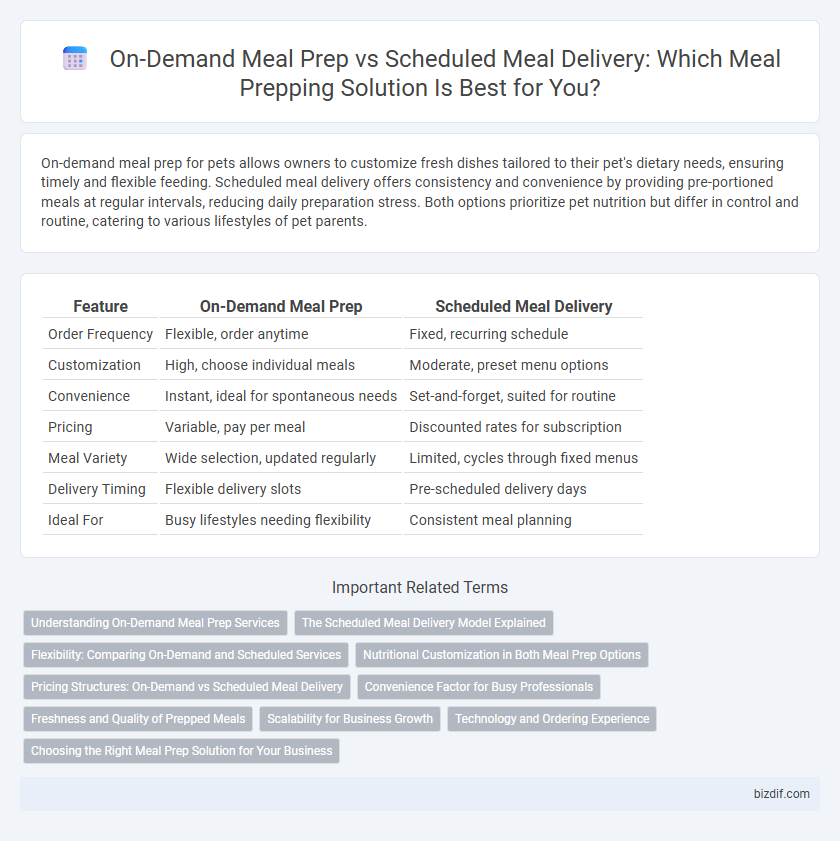On-demand meal prep for pets allows owners to customize fresh dishes tailored to their pet's dietary needs, ensuring timely and flexible feeding. Scheduled meal delivery offers consistency and convenience by providing pre-portioned meals at regular intervals, reducing daily preparation stress. Both options prioritize pet nutrition but differ in control and routine, catering to various lifestyles of pet parents.
Table of Comparison
| Feature | On-Demand Meal Prep | Scheduled Meal Delivery |
|---|---|---|
| Order Frequency | Flexible, order anytime | Fixed, recurring schedule |
| Customization | High, choose individual meals | Moderate, preset menu options |
| Convenience | Instant, ideal for spontaneous needs | Set-and-forget, suited for routine |
| Pricing | Variable, pay per meal | Discounted rates for subscription |
| Meal Variety | Wide selection, updated regularly | Limited, cycles through fixed menus |
| Delivery Timing | Flexible delivery slots | Pre-scheduled delivery days |
| Ideal For | Busy lifestyles needing flexibility | Consistent meal planning |
Understanding On-Demand Meal Prep Services
On-demand meal prep services provide customized meals ready for immediate pickup or delivery, catering to flexible schedules and specific dietary needs. These services prioritize convenience by allowing customers to order meals at any time without long-term commitments, contrasting with scheduled meal delivery that follows a fixed timetable. Understanding this flexibility helps consumers choose options that align with their lifestyle and nutritional goals.
The Scheduled Meal Delivery Model Explained
The scheduled meal delivery model offers customers pre-planned meals delivered at consistent intervals, ensuring convenience and meal variety without daily ordering. This system optimizes nutritional balance and portion control by relying on dietitian-approved menus tailored to specific dietary goals. Regular delivery schedules reduce decision fatigue and support long-term healthy eating habits compared to on-demand meal prep options.
Flexibility: Comparing On-Demand and Scheduled Services
On-demand meal prep offers unmatched flexibility by allowing customers to order meals whenever needed, accommodating sudden schedule changes and varied dietary preferences. Scheduled meal delivery services provide consistency with pre-planned meals arriving at set intervals, ideal for those with predictable routines and time management preferences. Consumers seeking spontaneous meal options benefit from on-demand services, while those prioritizing routine meal planning prefer scheduled deliveries.
Nutritional Customization in Both Meal Prep Options
On-demand meal prep offers unmatched nutritional customization by allowing consumers to select meals tailored to specific dietary preferences, allergies, and macronutrient goals in real-time. Scheduled meal delivery services also provide nutritional customization, but typically require customers to plan their meals in advance with options from preset menus designed to accommodate common dietary needs such as keto, vegan, or gluten-free. Both options leverage advanced nutrition tracking and personalized meal planning to optimize health outcomes based on individual nutritional requirements.
Pricing Structures: On-Demand vs Scheduled Meal Delivery
On-demand meal prep services typically charge per meal or order, offering flexibility but often at a higher price point due to instant preparation and delivery. Scheduled meal delivery plans feature subscription-based pricing, which reduces the cost per meal by committing to regular delivery cycles and bulk preparation. Consumers choosing between these options must weigh the premium cost of on-demand convenience against the cost-efficiency of scheduled meal plans.
Convenience Factor for Busy Professionals
On-demand meal prep offers unparalleled convenience for busy professionals by providing flexibility to order meals exactly when needed, eliminating the stress of meal planning and last-minute grocery shopping. Scheduled meal delivery services streamline weekly routines with pre-planned menus and consistent delivery times, reducing decision fatigue and ensuring a steady supply of nutritious meals. Both options enhance time management, but on-demand services cater better to unpredictable schedules, while scheduled deliveries excel in routine stability.
Freshness and Quality of Prepped Meals
On-demand meal prep offers greater flexibility, ensuring meals are freshly prepared right before delivery, which enhances both freshness and nutrient retention. Scheduled meal delivery may sacrifice some freshness due to batch preparation and longer storage times, but often maintains consistent quality through standardized recipes and controlled processes. Consumers prioritizing optimal freshness and high-quality ingredients tend to prefer on-demand services, while those valuing convenience may opt for scheduled deliveries.
Scalability for Business Growth
On-demand meal prep offers flexibility and rapid scaling possibilities by adapting quickly to fluctuating customer demands without heavy commitments. Scheduled meal delivery provides predictable revenue streams and operational stability, which supports steady long-term business growth. Balancing on-demand responsiveness with scheduled consistency enables scalable expansion while maintaining customer satisfaction.
Technology and Ordering Experience
On-demand meal prep leverages advanced mobile apps and AI-driven platforms to provide instant customization and real-time order tracking, enhancing user convenience. Scheduled meal delivery employs automated subscription systems and predictive algorithms to streamline weekly meal planning and ensure consistent supply. Both technologies prioritize seamless ordering experiences but differ in flexibility and personalization options.
Choosing the Right Meal Prep Solution for Your Business
On-demand meal prep offers flexibility and customization for businesses needing rapid turnaround and varied menu options, while scheduled meal delivery ensures consistency and reliability with batch preparation. Evaluating factors such as order volume, customer preferences, and operational capacity helps determine the optimal solution. Integrating technology for real-time tracking and efficient inventory management enhances both models' effectiveness.
On-demand meal prep vs Scheduled meal delivery Infographic

 bizdif.com
bizdif.com